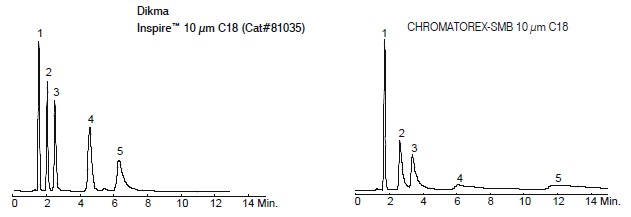- Home
- Products
- HPLC / UHPLC Columns
- Preparative Chromatography
Preparative Chromatography
Dikma prep materials are designed to provide fast separation with superior performance in suitable for the most demanding preparative applications. The stationary phases created by combining advanced bonding technologies with high surface area ultra-pure silica deliver superior resolution and loadability, extended column lifetime and excellent stability and reproducibility. With Dikma prep column you can load more samples and obtain a larger amount of purified product in less time.
Features of Dikma Preparative Chromatography Packing Materials :
Excellent Mechanical Stability
By optimizing pore volume, pore diameter, particle size structure, Dikma preparative chromatography packing materials maintain their physical and chemical integrity through repeated packing and unpacking cycles.
During the mechanical strength test, the same batch for Dikma Inspire™10 μm materials was packed, tested for column pressure, and then unpacked material. This process is repeated for 10 times in a 250 x 4.6 mm column at a pressure of 2,000 psi. The result of the pressure test as shown below did not significantly change.
The second test proves as well the mechanical strength of Dikma packing materials. The data illustrated clearly indicates a linear correlation between column pressure and packing pressure, which indicates that Dikma packing materials have strong mechanical stablity.
.png) .png) |
Quick and Easy Transition from Analytical to Prep
Dikma Technologies Inc. offers the same line of packing materials, although the particles are different with no change in selectivity and retention characteristics, to support rapid scale-up from analytical to preparative scale, making it more convenient for method development.
Scale up from analytical to prep is easily achieved without loss of performance. High-tech packing procedures in combination with the State-of-the-Art Dikma bonded phases ensure similar chromatographic performance regardless of dimension. This eliminates the need of additional timeconsuming method development. Dikma offers columns in 3, 5 and 10 μm particle sizes that make it easy to scale-up. The data demonstrates easy linear scale-up of natural products from 3 μm and 5 μm analytical columns to a 10 μm preparative column.
| Linear Scale-up | |||||||||||||||||||||
|
|||||||||||||||||||||
.png) |
|||||||||||||||||||||
| Linear Scale-up with LSF=1000 | |||||||||||||||||||||
|
|||||||||||||||||||||
.png) |
Maximum Loadability
The loadability is an important parameter for preparative chromatography as packing materials with high loading capacity and good separation efficiency can undoubtedly improve the overall yield. Dikma uses a proprietary technique to bond more alkyl groups to silica surface to increase the loadability of the packing material.
Dikma prep offers maximum loadability, which results in improved laboratory productivity by delivering more purified material per run time. Superior mass loading capabilities translate into less preparative runs for a given amount of pure material, resulting in faster purification and increased throughput.
|
||||||||||||||||||||||||
.png) .png) |
||||||||||||||||||||||||
.png) .png) |
||||||||||||||||||||||||
|
Increasing loadability did not reduce the resolution of compounds 1 and 2 |
||||||||||||||||||||||||
|
|
||||||||||||||||||||||||
|
||||||||||||||||||||||||
.png) .png) |
||||||||||||||||||||||||
.png) |
.png)
Outstanding Chemical Stability
Silica-based materials may be hydrolyzed or dissolved in the low pH or high pH, leading to loss of stationary phase and rapidly decreasing column efficiency. Dikma preparative chromatography packing materials have excellent stability in these extreme pH conditions. We continuously flushed a Dikma Inspire™ C18 column for more than 1440 hours at pH 1 and pH 11 respectively, and then recorded and calculated the retention time, asymmetry and capacity factor (as shown below). The experimental data show the Dikma Inspire™ C18 column can maintain outstanding tolerance and stability under extreme pH conditions.
|
|||||||||||||||||||||||||
.png) |
|||||||||||||||||||||||||
.png) |
|||||||||||||||||||||||||
.png) |
|||||||||||||||||||||||||
Ultimate Performance
Large-scale purification process consumes a large amount of solvents and increases production costs. Fast separation
without compromising resolution can reduce solvent use and production costs.
| Separation of Basic Compounds* | |||||||||||||||||||||||||||||||
|
|||||||||||||||||||||||||||||||
.png) .png) |
|||||||||||||||||||||||||||||||
.png) |
|||||||||||||||||||||||||||||||
| Separation of Acidic Compounds | |||||||||||||||||||||||||||||||
|
|||||||||||||||||||||||||||||||
.png) .png) |
|||||||||||||||||||||||||||||||
.png) |
|||||||||||||||||||||||||||||||
![]()
Unparalleled Performance
Dikma preparative chromatography packing materials are promoted by Dikma Technologies Inc. with independent intellectual property rights. Dikma adopts ultrapure spherical silica with a larger specific surface area and patented chemical bonding technology to ensure high resolution and shortened separation time, thereby increasing the loadability while saving solvent, and improving yield.
| Separation of Basic Compounds* | |||||||||||||||||||||||||||||||
|
|||||||||||||||||||||||||||||||
 |
|||||||||||||||||||||||||||||||
.png) |
|||||||||||||||||||||||||||||||
.png)
USA
51 Massier Lane
Foothill Ranch, CA 92610, USA
Tel: 1-866-889-9072
Fax: 1-866-833-2653
Email: sale@dikmatech.com
Business hours: 9 AM - 5 PM PST
Canada
255 Shields Court, Unit A
Markham, ON L3R 8V2, Canada
Tel: 905-944-8066
Fax: 905-944-0181
Toll-Free:1-866-889-9072
Email: sales@dimaglass.com
Business hours: 9 AM - 5 PM EST
Asia / Pacific Area
Room 9, 5F., No.763 Wenlin Road,
Shilin District, Taipei City
111, Taiwan
Email: paulw@dikmatech.com
.png)
.png)

